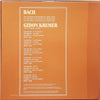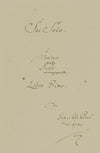





Bach - The Sonatas And Partitas For Solo Violi - Gidon Kremer (3LP, Box set, DMM)
Johann Sebastian Bach - The Sonatas And Partitas For Solo Violin
Gidon Kremer, Violin
3 LPs, Box set Including a Facsimile of Bach’s complete manuscript score
Direct Metal Mastering
Original analog Master tape : YES
Heavy Press : 180g Virgin vinyl
Record color : Black
Speed : 33RPM
Size : 12'’
Stereo
Studio
Record Press : Pallas (Germany)
Label : Analogphonic
Original label : Decca
Recorded on February & March 1980 at Lutheran Church, Haarlem, Netherlands
Direct Metal Mastering by Hans-Jorg Maucksch at Pauler Acoustics
Originally released in 1990
Reissued in 2015
Tracks :
Side A : Sonata No. 1 In G Minor, BWV 1001
- Adagio
- Fuga (Allegro)
- Siciliana
- Presto
Side B : Sonata No. 2 In A Minor, BWV 1003
- Grave
- Fuga
- Andante
- Allegro
Side C : Sonata No. 3 In C, BWV 1005
- Adagio
- Fuga
- Largo
- Largo
Side D : Partita No. 1 In B Minor, BWV 1002
- Allemanda - Double
- Corrente - Double (Presto)
- Sarabande - Double
- Tempo Di Borea - Double
Side E : Partita No. 2 In D Minor, BWV 1004
- Allemanda
- Corrente
- Sarabanda
- Giga
- Ciaccona
Side F : Partita No. 3 In E, BWV 1006
- Preludio
- Loure
- Gavotte En Rondeau
- Menuet I-ll
- Bourrée
- Gigue
Direct Metal Mastering
In Direct Metal Mastering, the cutting lathe engraves the audio signal directly onto a copper-plated master disc, instead of engraving the groove into a lacquer-coated aluminum disc.
The direct metal mastering technology addresses the lacquer mastering technology's issue of pre-echoes during record play, caused by the cutting stylus unintentionally transferring some of the subsequent groove wall's impulse signal into the previous groove wall. In particular, a quiet passage followed by a loud sound often clearly revealed a faint pre-echo of the loud sound occurring 1.8 seconds ahead of time (the duration of one revolution at 33 rpm). This problem could also appear as post-echo, 1.8 seconds after a peak in volume.
Another improvement is noise reduction. The lacquer mastering method bears a higher risk of adding unwanted random noise to the recording, caused by the enclosure of small dust particles when spraying the silvering on the lacquer master, which is the necessary first step of the electroplating process for reproduction of the master disc. As the DMM master disc is already made of metal (copper), this step is not required, and its faults are avoided.
With the groove being cut straight into a metal foil, this removed a number of plating stages in the manufacturing process. This gave rise to more upper frequency levels and less surface noise. Additionally, groove pre-echo problems are significantly diminished. Bass is typically tight and well defined, even described as more accurate than the fat, mushy sound of lacquered vinyl pressings.
Ratings:
Discogs : 4.56 / 5

